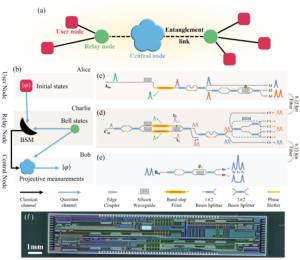Chip-to-chip photonic quantum teleportation over optical fibers of 12.3 km
FAYETTEVILLE, GA, UNITED STATES, July 10, 2025 /EINPresswire.com/ -- Quantum teleportation is a critical function in quantum networks, enabling quantum information transmission between distant nodes. While recent years have witnessed substantial advances in integrated quantum photonics, achieving long-distance quantum teleportation between quantum photonic chips remains a significant challenge. This work addresses this critical gap and achieves an experiment of chip-to-chip quantum teleportation with a transmission distance of 12.3 km over optical fibers, showing the potential of chip integration on the development of quantum networks.
Quantum teleportation is a crucial function in future quantum networks, transferring quantum states through prior-distributed entanglement. Photons, as "flying" qubits, are good carriers of quantum information to achieve long-distance quantum teleportation. The photonic quantum teleportation has been demonstrated over indoor fiber spools, metropolitan fiber cables and free space between satellite and ground. Quantum photonic circuits integrate multiple optical components onto a single chip to realize complicated quantum information functions, providing a promising way to simplify the implementation of photonic quantum teleportation. Although its feasibility has been shown in previous experiments over 10-meter optical fibers, more effort is required on enhancing performance of chip-to-chip quantum teleportation.
In a new paper published in Light Science & Application, a team of scientists, led by Professor Wei Zhang and Yidong Huang from Department of Electronics, Tsinghua University, China, and co-workers have extended optical fiber transmission distance of chip-to-chip quantum teleportation by three orders of magnitude. They used time-bin encoding photonic states in their experiment since it is robust to the fluctuations introduced by optical fiber transmission. They designed and fabricated three quantum photonic circuits on a single silicon photonic chip, each serving specific functions: heralded single-photon generation at the user node, entangled photon pair generation and Bell state measurement (BSM) at the relay node, and projective measurement of the teleported photons at the central node. In the experiment, the heralded photons with time-bin encoding states generated at the user’s circuit were sent to the relay node through fiber spools. Time-bin entangled photon pairs were generated at the relay node’s circuit, one photon of a photon pair was used to take on-chip BSM with the photon sent from the user, the other photon was sent to the central node through another fiber spools. The states of the teleported photons received at the central node is measured by its circuit. As the result, they achieve the photonic quantum teleportation over optical fibers of 12.3km based on these quantum photonic circuits, showing the potential of chip integration on the development of quantum networks.
To achieve such an improvement on chip-to-chip quantum teleportation, careful designs were made on both quantum photonic circuit design and system implementation. The unbalanced Mach-Zehnder interferometers (UMZI) for time-bin encoding in these quantum photonic circuits are optimized to reduce insertion losses and suppress noise photons generated on the chip. Besides, they established an active feedback system in the experiment to suppress the impact of fiber length fluctuation between the circuits, achieving a stable quantum interference for the Bell state measurement in the relay node. The authors of this work summarize these points as
“A key point of this work is the use of on-chip time-bin encoded quantum states, implemented via unbalanced Mach-Zehnder interferometers (UMZIs) with an optical path difference of 400 ps. By optimizing the waveguide structure, we reduced the propagation loss of the delay waveguides in the UMZIs to as low as 0.2 dB/cm. Additionally, we integrated waveguide Bragg grating (WBG) band-stop filters to effectively eliminate the unwanted pump light in the UMZI.”
“The experimental setup incorporates an active feedback system to stabilize the impact of fiber length fluctuations between the user and relay nodes. This stabilization is achieved using a variable optical delay line that dynamically compensates for fiber length variations, thereby maintaining synchronization despite environmental perturbations.”
“The particular designs of the on-chip UMZIs successfully suppressed photon noise and enhanced the quality of both heralded single-photon states and entangled Bell states generated through spontaneous four-wave mixing in silicon waveguides. And the active feedback system ensures stable quantum interference necessary for Bell state measurements. These techniques pave the way to achieve high performance chip-to-chip quantum teleportation.”
References
DOI
10.1038/s41377-025-01920-z
Original Source URL
https://doi.org/10.1038/s41377-025-01920-z
Funding Information
This work was supported by the National Natural Science Foundation of China (92365210, WZ), National Key R&D Program of China (2023YFB2806700, YH), Innovation Program for Quantum Science and Technology (2023ZD0300100, LY), Tsinghua Initiative Scientific Research Program (WZ) and the project of Tsinghua University-Zhuhai Huafa Industrial Share Company Joint Institute for Architecture Optoelectronic Technologies (JIAOT, YH).
Lucy Wang
BioDesign Research
email us here
Legal Disclaimer:
EIN Presswire provides this news content "as is" without warranty of any kind. We do not accept any responsibility or liability for the accuracy, content, images, videos, licenses, completeness, legality, or reliability of the information contained in this article. If you have any complaints or copyright issues related to this article, kindly contact the author above.
